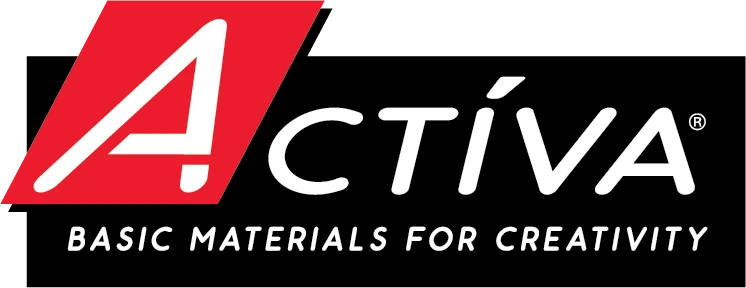How-to-Use Li-Qua-Che, with Sallie Strauss [Part 1]
Our newest product, Li-Qua-Che Pourable Paper Mache'. A marvelous non-fired casting medium that air cures. You do not need a kiln. And, it is painted with any non-fired paint, stain or glaze. And, first I would like to show you how to mix it before we pour in a ceramic mold. Now this particular medium must be used with a ceramic mold. The same plaster mold that you would use to pour ceramic slip or porcelain. And, ah… this is a gallon of Li-Qua-Che. And, it comes with a nice foil seal which has been removed. And, we ship it intentionally very, very thick. I like to tell people it's like oatmeal gruel. And, you pour the amount that you need for the pour in to a separate container. In to a plastic cup. I find is a very nice container to use. Now, you see it's quite thick, and you must dilute it down to about the consistency of heavy cream before it is poured or whipped. And, with that you want to use distilled water. And, you can use up to 5 TBS. of water per 8 oz. of Li-Qua-Che. And, you really dilute it the strength that you need for your particular pour. After you've used Li-Qua-Che for a while you really won't have to do so much careful measuring, you'll just sort of know the strength that you need. And, you want to mix it... and you don't want to pour it with a lot of bubbles in it. So, what you do...you see here were…were get...were getting a few bubbles in the mixing. You want to mix it and let it sit or minutes before you make the pour. Make certain that the water is thoroughly incorporated. And, I have some I have mixed up about 5 minutes ago, and I was going to let sit so the bubbles are out. So, I'll move this over. And, this is what it should look like. And, now we need our plaster mold. And, this particular mold are fish. And, this is a 2 part mold. You can use it in a 1or a 2 part mold. It can be used in a 3 part mold. And, then you would just...ah… add any parts that need to be joined together. Use Li-Qua-Che as a glue. So, first you have to close your mold with rubber band. Now, I pour dry… ah, when you think about a mold, really all a mold is a sponge that is wicking the water away. So, you don't really want to wet the mold before your pour, because you don't want a lot of water here. You put on your rubber band. And, take the Li-Qua-Che...This is the cavity and you see there's some little areas here that sort of meet. It's good to pour on top of those, because you'll get fewer bubbles. Now, you can see this is… I call this the pour hole. You can see that the Li-Qua-Che has come up here and it's very quickly sinking......in to the mold. And, I keep adding a little bit more Li-Qua-Che as I go. I'll maybe do this 2 or 3 times. And, we will show...pour a simple 1 part mold to show you how this works. Will do a shell.--tap-- --tap-- --tap-- --tap-- --tap-- --tap--And, a little heart. And, if you are very careful and don't over pour...on these you really don't have to trim the seams. You see how this has begun to sink down. I'm gonna add just a little bit more. And, then I'll let it sit for a couple minutes. And, then we will do what we call a pour off. And you can see here how it is thickening around the pour hole. And, what you want to do is you watch this and then you will pour off at the thickness that you would like your piece to be. We've left the Li-Qua-Che in the mold for about and a 2 and 1/2 minutes. You can leave it anywhere from 2 to 4 minutes depending on the thickness that you want. And, what we do now is what in the ceramic field they call pouring off. We're going to invert the mold. And, you’re going to pour the excess Li-Qua-Che that has not set in here. You’re going to reclaim this. And, any Li-Qua-Che that is still liquid can be added back to your cup, and it can be put back in the container. Even though it has been diluted that dilution will not effect this. But, remember only dilute the amount that you need at a time. From a gallon of material when you figure dilutions, you end up ah... with approximately a gallon and a 1/3 to a gallon and 1/2 material. And, in your dilutions, please use distilled water. We like to think our water supplies are the safest in the world, but in the manufacturing process we do use distilled water, so we suggest that you use distilled. And, if not that certainly bottled water for your dilutions. Now, you can see here I have reclaimed. Here's your Li-Qua-Che that you would pour back in to your cup. Or, I could have done it this way, but this is, you…see...this is kind of pro-curious. Now, you can see in here I have little air bubble. I'm just gonna blow in to the cavity with a straw like this... And, you see this is shiny and wet. This is beginning to be dull. It's already dry. But, it is going to take about 20 minutes before I can open the mold and remove the...ah... casting and clean the seams. That is what you do with a part, a... ah... part mold. On a part mold, you can see here that this is shrinking and drying very nicely. I will not make any pour off on the little heart, because it is such a shallow item you don't want to make it any thinner. This particular shell... ... And, now that each have rested for about 20 minutes, it's time to take them out of the mold. And, first we will un-mold the 1 part molds. And, you see how nicely they have dried, and the area that we have poured off is very smooth. And, this is where the paper is. Your paper goes to the back or the interior of the mold, and gives it the strength and the stability and the lightness. And, your smooth small particle comes to the face of the mold. Sometimes you might need a little scalpel knife or a little lifting tool. We have very, very simple tools here. A scalpel knife, ah...a little lifting tool, a scraping tool, and some little cat tail sponges. And, there's no way around seems, the, ah...the only thing you really need clean, the only clean up the Li-Qua-Che cast people's needs are, ah... around the seams and around the edges. And, you take a little cat tail sponge... you dip it in a little water. And, you just go right around the edge. And, that takes any residue off. And, then get out your cake or cookie rack. And that is how... where you’re going to, um...elevate them so that the air circulates all around, and dries them. You see the lovely texture and detail this has pulled. And, from this mold...This is a smooth mold and you see how smooth this is. And, you really don't need to do anything here, but then again with your cat tail sponge you just rub the edges. Put this over here to dry. Now we will open the part mold. And, this is always like Christmas morning, but it's not like having to fire something in a kiln, because kiln and sometimes you put things in a kiln and you are not quite sure what's gonna come out. This way you know immediately... as soon as your mold is open. And, there's the casting, and here is your mold. And, this is important thing we're always asked. Can I go back and pour porcelain and ceramic in this mold or is this only dedicated to Li-Qua-Che? As you can see Li-Qua-Che leaves no residue at all. And, you can go right back and pour your porcelain slip and your ceramic slip in the mold. And, in no way does Li-Qua-Che damage it. Being paper it is not as wet, and or as abrasive as porcelain or ceramic slip. And, you can do more frequent pours. You really do not have to rest the mold the way you...as much as you do with the other traditional ceramics. And, this you can see he's almost ready to pop out on his own. And, I keep the pour holes on and just lift a little bit here, and boom...he's out. Now it... there's... This was a wonderful casting. There are no tiny pinhole bubbles. But, in the event that you ever get a pinhole bubble on a casting...all you need do...is Take a little of the solid seam or trim. I do see tiny little hole here. And, I'm beginning to clean the edges. It's easier to clean when it's wet. There's just less work involved. But, you see your putting a solid in a solid. And, you just covered those little holes up. And, with your scalpel knife...you just want to go along the seams very carefully. I just like to scrape. And, this really… on a piece like this is really the only thing that's necessary. There is no sanding or cleaning of the piece. People ask me all the time... Can I sand it? Well, that... that brings terror to my heart, because this is so smooth, you can see how smooth it is here. You do not in any way want to sand it, because remember this is paper. And, if you sand it you’re going to bring up the nap of paper fiber and you don't want that little fuzz. But, see I scrapped it with a little scalpel knife. And, then take your damp cat tail sponge… go over the seam. And, you see how easily this is coming off. --- PLEASE PROCEED TO PART 2 ---




 />
/>
 />
/>